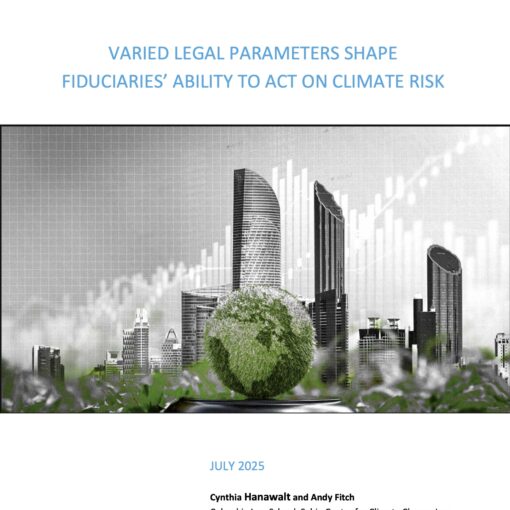 Nearly two years and 24,000 public comments after its proposal, the Securities and Exchange Commission (SEC) released its final climate disclosure rule last week, formally titled “The Enhancement and Standardization of Climate-Related Disclosures for Investors.”
Nearly two years and 24,000 public comments after its proposal, the Securities and Exchange Commission (SEC) released its final climate disclosure rule last week, formally titled “The Enhancement and Standardization of Climate-Related Disclosures for Investors.”
The rule expands public companies’ disclosure requirements to include certain greenhouse gas (GHG) emissions data and information regarding climate-related financial risks. Advocates, critics, and journalists have written extensively about the final rule, its legitimacy, and its importance. This post is the first in a series of three that will address specific legal features of the rule.
Part One, below, offers a summary of the final rule, and delves into the materiality threshold that was added throughout the rule, including for greenhouse gas (GHG) emissions disclosure
Part Two considers the future of the climate disclosure rule in the context of the SEC’s rulemaking process.
Part Three explores preemption questions in the context of other domestic frameworks: California’s climate-disclosure laws and the Environmental Protection Agency (EPA)’s GHG emissions reporting regime.
Requirements of the SEC’s Final Rule
The final rule adopted last week requires public companies to disclose information in three key areas: (1) climate-related financial risks, (2) GHG emissions, and (3) any climate-related targets or transition plans.
With respect to the first category, registrants must disclose climate-related risks that are reasonably likely to have a material impact on the registrant’s business strategy, operational results, or financial condition. Firms must also disclose the actual and potential material impacts of any identified climate-related risks on their strategy, business model, and outlook. Any board oversight, processes and management related to climate-related risks must also be disclosed. However, any board area expertise with respect to climate need not be disclosed, a requirement that was included in the March 2022 proposed rule but does not appear in the final version.
Registrants must also disclose several financial impacts incurred as a result of severe weather events and other natural conditions, subject to a 1% change threshold in a note to financial statements. If the estimates or assumptions the corporation uses to produce their financial statements were materially impacted by climate risks, a qualitative description must be included. And, if a registrant has undertaken any climate mitigation efforts, then those efforts must be disclosed as well, including a quantitative and qualitative description of material expenditures, plus any material impacts on financial estimates and assumptions that stem from those mitigation efforts.
With respect to GHG emissions disclosure, large accelerated filers (LAFs) and accelerated filers (AFs) – meaning, companies with a publicly traded equity value of $75 million or more – must file information about their material Scope 1 and 2 emissions. These disclosures are subject to progressively stronger audit requirements, first to limited assurance and eventually reasonable assurance.
Finally, registrants must disclose any targets or goals related to climate change that materially affect the registrant’s business. Included in this requirement are any material expenditures and impacts on financial estimates and assumptions that result from the target or goal. Additionally, filers must include financial impacts related to carbon offsets and renewable energy credits or certificates (RECs) if used as a material part of their disclosed climate-related targets or goals. Relatedly, the rule also mandates disclosure of a registrant’s use (if any) of transition plans, scenario analysis, and internal carbon pricing.
The rule will be phased in over an extended period. LAFs must comply with most disclosures for fiscal year beginning (FYB) 2025, FYB 2026 for GHG emissions and the remaining required disclosures, and reach limited assurance for their GHG emissions disclosures for FYB 2029. In practice, this means initial disclosures under the regime will be filed in 2026. AFs and other registrants will follow suit as required on a more delayed timeline. While most disclosures are due in annual reports, reporting of GHG emission information can be delayed to the second quarter of the fiscal year after the emissions occurred.
The rule also includes a “safe harbor” provision that protects issuers from private liability for forward-looking climate-related disclosures pertaining to transition plans, scenario analysis, carbon pricing, and any stated climate goals. This “safe harbor” addresses opponents’ concerns about legal liability for forward-looking statements about climate-related issues.
Key Changes from the Proposal
As previewed by SEC Chair Gary Gensler, the final rule was significantly scaled back from the proposal published by the Commission in 2022. Notably, the final rule does not require any registrants to disclose their Scope 3 GHG emissions, meaning that public companies will not have to disclose their supply chain emissions. This was a significant concession to the rule’s opponents. Scope 3 emissions comprise up to 80% of many companies’ aggregate GHG emissions, and regulators in many other jurisdictions have concluded that these disclosures are critical for investors to understand a company’s full climate-related financial risk.
The revised rule also only requires Scope 1 and 2 GHG reporting for LAFs and AFs, so smaller publicly traded companies are now exempt from the obligation to report their emissions at all. And, as detailed below, the final rule also includes a new materiality qualifier for this Scope 1 and 2 GHG emissions information as well as other climate risk disclosures.
The final rule also removes the line-item disclosure requirement that was meant to show the impact of transition activities on a company’s bottom line. Further, the impact of severe weather events, which was originally required as a footnote disclosure in a firm’s Regulation S-X reporting, has been shifted to Regulation S-K. This is a non-trivial shift, as these numbers will no longer be subject Reg S-X’s audit requirements.
The Materiality Qualifier
One area where the final rule looks dramatically different from the proposed rule is the inclusion of a materiality threshold for Scope 1 and 2 GHG emissions disclosure and for various climate risk and transition disclosure requirements throughout. Materiality is described in the rule as “defined by the Commission and consistent with Supreme Court precedent.” The SEC goes on to explain in the rule that, “a matter is material if there is a substantial likelihood that a reasonable investor would consider it important when determining whether to buy or sell securities or how to vote or such a reasonable investor would view omission of the disclosure as having significantly altered the total mix of information made available. The materiality determination is fact specific and one that requires both quantitative and qualitative considerations.”
As noted in this definition, materiality is an objective standard and particular to each company’s unique total mix of information. In 1999, the SEC released a Staff Accounting Bulletin and then adopted it as interpretive guidance, making clear that materiality is a qualitative test, not subject to any bright line threshold test for financial impact. This is supported by Supreme Court precedent from Basic v. Levison, 485 U.S. 224 (1988) and TSC Indus. V. Northway, Inc., 426 U.S. 438 (1976). Basic stated that materiality should remain a high enough standard to prevent investors from being buried in “an avalanche of trivial information” which would be “hardly conducive to informed decision making.” Indeed, in TSC, the court held that one of the key features of materiality is that the piece of information would have actual significance to a reasonable shareholder’s deliberations.
As former Acting Chair of the SEC Allison Lee has observed, some argue – incorrectly – that the SEC is prohibited from requiring specific disclosures unless it can demonstrate that each disclosure is individually material to the bottom line of every public company. One source of confusion about materiality may be the different standard applicable to anti-fraud provisions. Under Rules 10b-5 and 14a-9 of the Exchange Act, courts have indeed held that materiality is required for these scienter-based anti-fraud rules. However, this requirement is not broadly applicable to the SEC’s disclosure authority. Nowhere in Section 7 of the Securities Act of 1933 does it say that the SEC can only require “material” disclosures. Rather, the section authorizes the SEC to require disclosures in the public interest and for the protection of investors. The same holds true for the 1934 Securities Exchange Act Sections 12, 13 and 15.
Indeed, the SEC has a clear history of requiring disclosures that may not always be material. As Commissioner Lee noted, Regulation S-K has traditionally required a broad array of information that may not be material for every company, given materiality is an analysis that is determined on a case-by-case basis and can vary from moment to moment for a corporation.
For example, in Reg S-K, the SEC requires any registrant that is an operator of a mine, without any reference to size or financial import, to disclose a variety of safety and operating metrics that may have limited impact on the corporation’s bottom line. This is predicated on the fact that the safety of mine workers is an important public policy issue and merits disclosure in keeping with the SEC’s mandate, regardless of whether the mine is material to the overall operations of the registrant. Additional topics have included share buybacks, related party transactions, environmental proceedings, and executive compensation, all without materiality because they are important to investors and to corporate transparency.
And yet, the SEC decided to impose a materiality qualifier throughout the final rule. Some advocates in the sustainability community support this threshold, arguing that a looser standard could lead to an unintelligible sea of information, not unlike the avalanche of information the Court warned against in Basic. And in an Investor Advisory Committee panel the day after the rule was released, Lynn Turner stated that he believes the materiality threshold is crucial to the rule’s legal durability. Turner was one of the original drafters of SAB 99, the internal guidance the SEC still relies for assessing materiality. He indicated that a reviewing court’s deference to the Agency’s interpretation underpinning the rule may be increased by tying the climate disclosures to materiality for investors. However, just because the rule may be more durable in court does not mean that approach is without risk.
Risks of Applying the Materiality Threshold
There are two significant risks in applying materiality qualifiers to the final climate rule: (1) uncertainty for companies making internal materiality assessments and (2) an implication that the SEC’s disclosure authority may be limited to material information, ultimately reducing comparability for investors.
During the same recent panel on materiality, Professor George Georgiev stated that he does not believe the materiality qualifier will significantly change how many registrants ultimately disclose their GHG emissions, because an incorrect finding of immateriality comes with legal risk. A materiality determination is costly and complex, and companies are vulnerable to liability, including lawsuits from their own shareholders, if their assessment is wrong. Given these costs and risks, the materiality qualifier may ultimately not be an advantageous provision for most firms.
Further, as Allison Lee noted upon the rule’s release, including a materiality qualifier sets questionable precedent, potentially suggesting the SEC’s authority is cabined to requiring disclosure of material information. While the Commission likely made a strategic decision here to hinge emissions disclosure on materiality in order to withstand the scrutiny of more conservative circuits, they may have created risk for future rules to be challenged if they seek novel or less quantitatively measurable information. If the SEC’s authority is limited to a regime dominated by materiality analyses, comparability will also be destroyed, due to the fact-intensive nature of a materiality inquiry. As Commissioner Lee noted, this would be at odds with modern capital markets, which seek comparability and consistency in disclosures without regard to the unique circumstances of each registrant. Tying the SEC’s hands with materiality requirements could ultimately undermine the consistency and comparability of data that disclosure rules, like this one, are meant to provide for investors.






